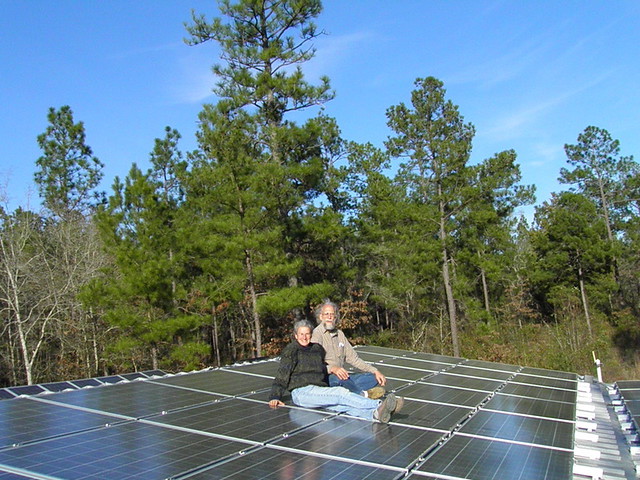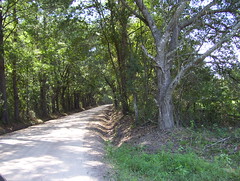I wanted to remember what it was like before it got paved so I took this video.
-gretchen
-gretchen
 Nature is not something
out there, apart from people.
It never was, and nowadays people have built and farmed and clearcut
so much that wildlife species from insects to birds are in trouble.
In south Georgia people may think that our trees make a lot of wildlife habitat.
Actually, most of those trees are planted pine plantations with
very limited undergrowth, and in town many yards are deserts of grass
plus exotic species that don’t support native birds.
Douglas Tallamy offers one solution:
turn yards into wildlife habitat by growing native species.
Since we are as always remodeling nature, we might as well do it
so as to feed the rest of nature and ourselves,
and by the way get flood prevention and possibly cleaner water as well,
oh, and fewer pesticides to poison ourselves.
Nature is not something
out there, apart from people.
It never was, and nowadays people have built and farmed and clearcut
so much that wildlife species from insects to birds are in trouble.
In south Georgia people may think that our trees make a lot of wildlife habitat.
Actually, most of those trees are planted pine plantations with
very limited undergrowth, and in town many yards are deserts of grass
plus exotic species that don’t support native birds.
Douglas Tallamy offers one solution:
turn yards into wildlife habitat by growing native species.
Since we are as always remodeling nature, we might as well do it
so as to feed the rest of nature and ourselves,
and by the way get flood prevention and possibly cleaner water as well,
oh, and fewer pesticides to poison ourselves.
Douglas Tallamy makes a clear and compelling case in
 Bringing Nature Home: How You Can Sustain Wildlife with Native Plants
Bringing Nature Home: How You Can Sustain Wildlife with Native Plants
…it is not yet too late to save most of the plants and animals that sustain the ecosystems on which we ourselves depend. Second, restoring native plants to most human-dominated landscapes is relatively easy to do.
Some of you may wonder why native species are so important? Don’t we have more deer than we can shoot? Maybe so, but we have far fewer birds of almost every species than we did decades and only a few years ago.
Some may wonder: aren’t exotic species just as good as native ones,
if deer and birds can eat them?
Actually, no, because many exotic species are poisonous
 to native wildlife, and because invasive exotics crowd out natives
and reduce species diversity.
From kudzu to
Japanese climbing fern, exotic invasives are bad for wildlife
and may also promote erosion and flooding by strangling native vegetation.
to native wildlife, and because invasive exotics crowd out natives
and reduce species diversity.
From kudzu to
Japanese climbing fern, exotic invasives are bad for wildlife
and may also promote erosion and flooding by strangling native vegetation.
All plants are not created equal, particularly in their ability to support wildlife. Most of our native plant-eaters are not able to eat alien plants, and we are replacing native plants with alien species at an alarming rate, especially in the suburban gardens on which our wildlife increasingly depends. My central message is that unless we restore native plants to our suburban ecosystems, the future of biodiversity in the United States is dim.
Tallamy had an epiphany when he and his wife moved to 10 acres in Pennsylvania in 2000:
Continue readingAcording to U.S. Drought Monitor, drought throughout south Georgia and surrounding areas is either extreme or exceptional, and has been for months.
Here you can see detail for Georgia:
Continue readingThe only well in the Withlacoochee, Little, or Alapaha River watersheds that seems to be instrumented for near-realtime depth measurements is in Valdosta. That well is now at historic lows, compared to 55 years of back data.
 On the
graph to the right, the black triangle in the middle of the green is the median over those 55 years since 1957. The green is 25th to 75th percentile. The yellow is 10th to 24th percentile. The red is below 10th percentile. I’m guessing below the red means never been seen that low before in that month.
On the
graph to the right, the black triangle in the middle of the green is the median over those 55 years since 1957. The green is 25th to 75th percentile. The yellow is 10th to 24th percentile. The red is below 10th percentile. I’m guessing below the red means never been seen that low before in that month.
The current depth shown, 137.52 feet below the surface on 26 April 2012, is not the lowest ever seen, which was 152.31 feet on 19 September 1990. But apparently it is lower than seen before for April.
Maybe we should think about water conservation more frequently than just when Valdosta’s water pumps have problems. Not just for watering lawns; also for agriculture and silviculture. Maybe we should try to plant crops that don’t require as much irrigation, or plant them in ways that don’t lead to so much evaporation. Maybe we should be more careful about clearcutting trees, which causes rapid runoff that doesn’t get back into the groundwater as much. Maybe we should think about how much growth do we want.
-jsq
We’re on Georgia Water Coalition’s Dirty Dozen 2011: as 9. South Georgia Wetlands: Four Decades of Ditches Dry Out South Georgia Wetlands:
Since the 1970s, state and federal regulatory agencies have allowed the destruction of more than 200,000 acres of highly critical wetlands throughout South Georgia to increase timber production and agricultural yields and usher in residential and commercial development. These wetlands that captured water and slowly released it to streams no longer perform that important function. The result has been increased floods when it rains and record low flows when it doesn’t….
Flooding? Like the 700 year flood in Lowndes County 3 years ago today?

What’s a wetland, anyway?
the greatest concentration of wetlands is in the Coastal Plain of South Georgia. Though these forested foodplains and wetlands may not seem directly linked to our rivers and streams, they play an important role in holding water during rain events and dispensing it during dry periods. The sponges and kidneys of our state, they mitigate major floods, lessen the impacts of drought, and clean the water that passes through them, while regulating the amount of freshwater entering Georgia’s coastal estuaries where commercially important seafood find critical habitat. Additionally, these wetlands provide important habitat for waterfowl and other wildlife.
So what’s the problem?
In an effort to convert these wild lands intoContinue reading

Photo CC BY-ND Okra Paradise Farms
You can see the old panels sticking up on the left, and we’re sitting on some of the new panels, which continue on the lower roof on the right.
 These panels were purchased with the assistance of a
USDA Rural Energy for America Program (REAP) 25% grant:
These panels were purchased with the assistance of a
USDA Rural Energy for America Program (REAP) 25% grant:
Eligible projects include those that derive energy from a wind, solar, biomass, or geothermal source, or hydrogen derived from biomass or water using wind, solar, or geothermal energy sources.The REAP program will probably be renewed this year, so if you have a farm, you could apply.
 We also applied for and got a
We also applied for and got a
 U.S. Treasury 30% grant from the
1603 Program: Payments for Specified Energy Property in Lieu of Tax Credits.
That program was funded by the
The American Recovery and Reinvestment Act of 2009 (Recovery Act).
U.S. Treasury 30% grant from the
1603 Program: Payments for Specified Energy Property in Lieu of Tax Credits.
That program was funded by the
The American Recovery and Reinvestment Act of 2009 (Recovery Act).
Finally, there is the Georgia Environmental Finance Authority (GEFA) 35% Clean Energy Property Tax Credit, which will apply in parts over four years.
That all adds up to 90% covered by grants and tax credits, which is a pretty good deal.
Now that remaining 10% is still a significant amount;
like the price of a small car.
But in 7-15 years (how long it will take to pay off this system,
depending on how you figure it),
what would
 the value of a car be?
Much less than when you bought it.
Meanwhile, these solar panels will be generating almost as much
power as they are now, and they will continue to generate for
at least a decade more, probably much more.
the value of a car be?
Much less than when you bought it.
Meanwhile, these solar panels will be generating almost as much
power as they are now, and they will continue to generate for
at least a decade more, probably much more.
The big missing piece is up-front financing. For more on that, see other blog post.
Meanwhile, we have here on our workshop roof a proof of concept, operational right now.
The little dogs wanted to know what we were doing on the roof: Continue reading
“from a traffic safety perspective, the modern commercial arterial is a perfect storm of bad planning and design. These roads are designed to support high operating speeds, making it difficult for drivers to stop quickly to avoid a crash, and the presence of commercial and retail uses on these roads means that drivers will routinely need to stop quickly in order to avoid crashing into pedestrians, bicyclists, and especially vehicles turning in and out of driveways.”The 2006 article, Safe Urban Form: Revisiting the Relationship Between Community Design and Traffic Safety, by Eric Dumbaugh and Robert Rae, notes: Continue reading
 Beta New Urban Network reported 1 September 2006 that
Research: trees make streets safer, not deadlier:
Beta New Urban Network reported 1 September 2006 that
Research: trees make streets safer, not deadlier:
Proposals for planting rows of trees along the roads — a traditional technique for shaping pleasing public spaces — are often opposed by transportation engineers, who contend that a wide travel corridor, free of obstacles, is needed to protect the lives of errant motorists.The study asks a key question: Continue readingIncreasingly, however, the engineers’ beliefs about safety are being subjected to empirical study and are being found incorrect. Eric Dumbaugh, an assistant professor of transportation at Texas A&M, threw down the gauntlet with a long, carefully argued article, ”Safe Streets, Livable Streets,” in the Summer 2005 issue of the Journal of the American Planning Association. A follow-up article by Dumbaugh, in the 2006 edition of Transportation Research Record, will present further evidence that safe urban roadsides are not what the traffic-engineering establishment thinks they are.
Though engineers generally assert that wide clear areas safeguard motorists who run off the roads, Dumbaugh looked at accident records and found that, on the contrary, wide-open corridors encourage motorists to speed, bringing on more crashes. By contrast, tree-lined roadways cause motorists to slow down and drive more carefully, Dumbaugh says.
Dumbaugh examined crash statistics and found that tree-lined streets experience fewer accidents than do “forgiving roadsides” — those that have been kept free of large, inflexible objects. He points to “a growing body of evidence suggesting that the inclusion of trees and other streetscape features in the roadside environment may actually reduce crashes and injuries on urban roadways.”
 Vandana Shiva writes in Huffington Post about India:
Vandana Shiva writes in Huffington Post about India:
200,000 farmers have ended their lives since 1997.In just one Indian state:
1593 farmers committed suicide in Chattisgarh in 2007. Before 2000 no farmers suicides are reported in the state.Why?
In 1998, the World Bank’s structural adjustment policies forced India to open up its seed sector to global corporations like Cargill, Monsanto and Syngenta. The global corporations changed the input economy overnight. Farm saved seeds were replaced by corporate seeds, which need fertilizers and pesticides and cannot be saved.And that’s not all: Continue readingCorporations prevent seed savings through patents and by engineering seeds with non-renewable traits. As a result, poor peasants have to buy new seeds for every planting season and what was traditionally a free resource, available by putting aside a small portion of the crop, becomes a commodity. This new expense increases poverty and leads to indebtness.